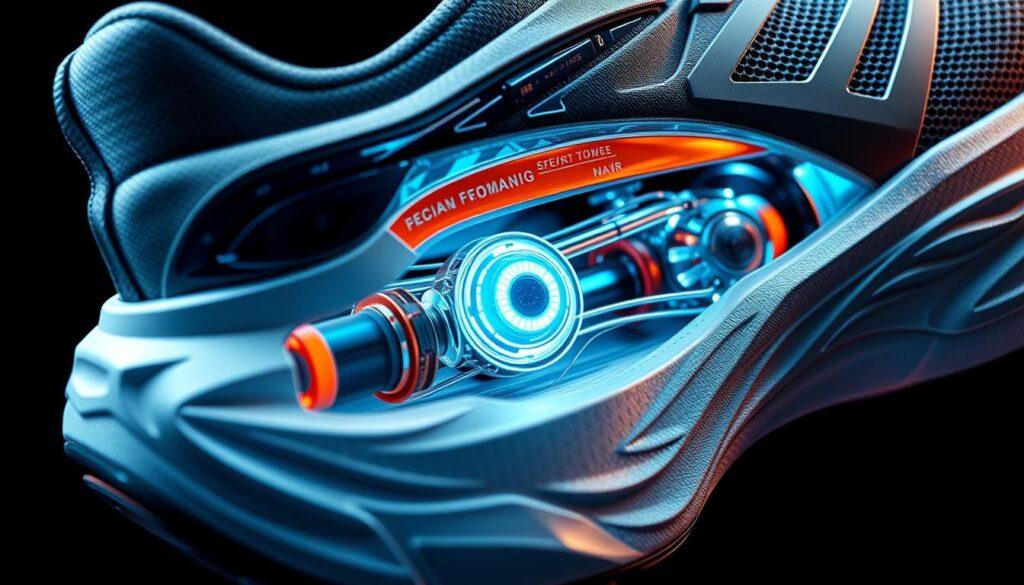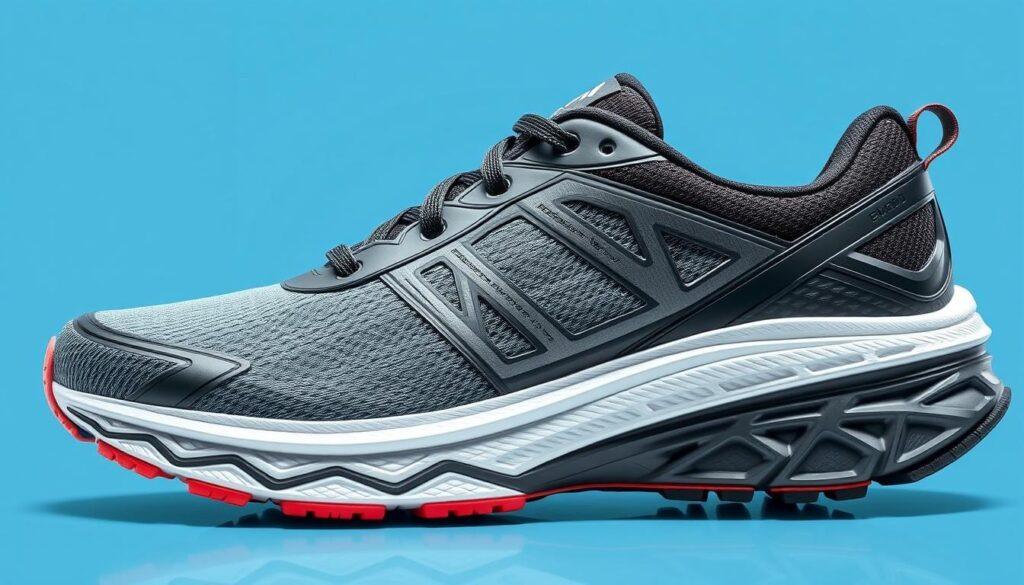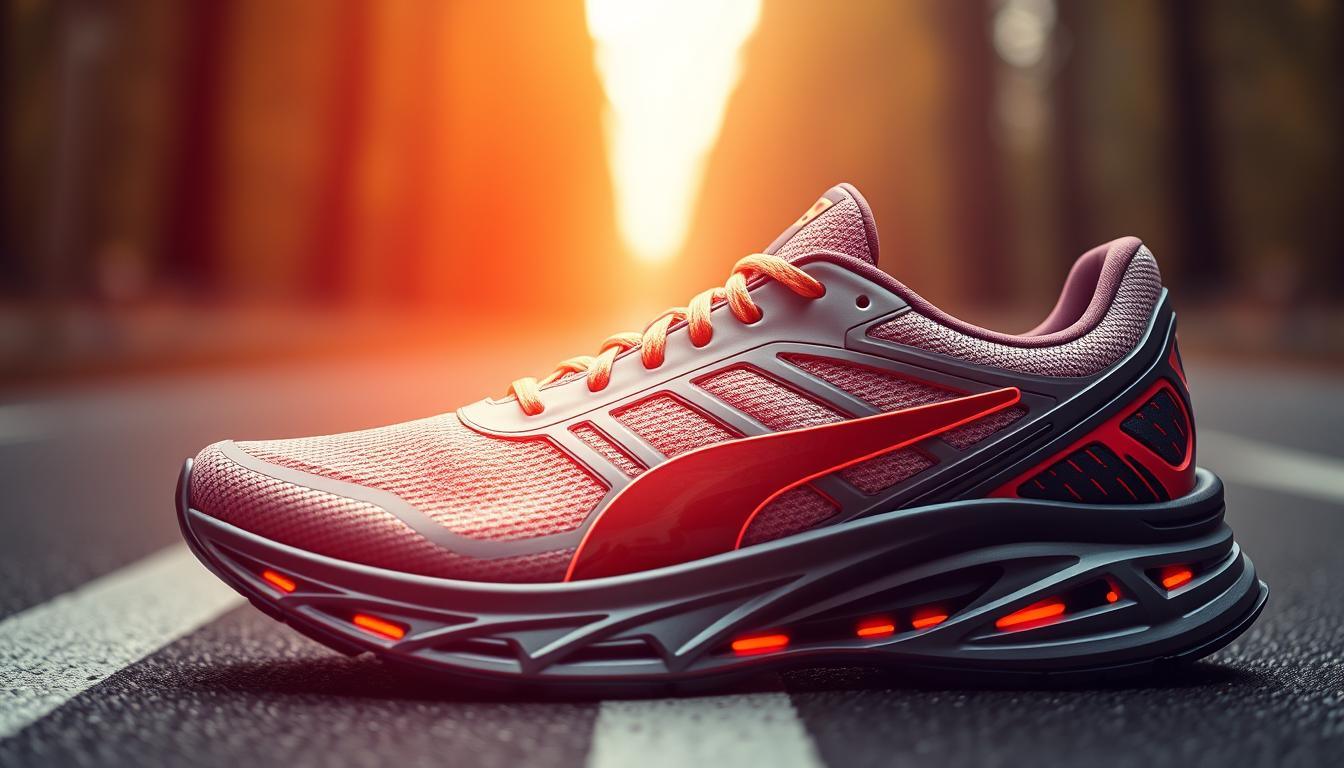Getting ready for your next long-distance run? It’s key to pick the right Running Shoes. These shoes must offer comfort, support, and last long to help you achieve your goals. With many choices, finding the perfect pair can seem tough. But, with the right advice, you can make a smart choice.
The right Running Shoes are vital for long-distance running. They must keep up with your intense training and support your body to avoid injuries. In this article, we’ll look at what to consider when picking the best Running Shoes for long-distance running.
Introduction to Long-Distance Running
Long-Distance Running is a tough yet rewarding sport. It demands commitment, effort, and the right gear. With the right Running Shoes, you can boost your performance, lower injury risks, and enjoy your runs more.
Key Takeaways
- Choose Running Shoes that provide the necessary comfort and support for Long-Distance Running
- Consider the type of terrain you’ll be running on and select shoes that can handle the conditions
- Think about your personal running style and select shoes that can accommodate your needs
- Don’t forget to consider the durability and lifespan of your Running Shoes
- Invest in a good pair of Running Shoes to improve your performance and reduce your risk of injury
- Long-Distance Running requires a specific type of shoe that can provide the necessary support and comfort
Understanding Your Long-Distance Running Needs
Getting ready for Marathon Training means knowing your running style and how it affects your shoe choice. New advancements in Running Shoe Technology help improve your performance and lower injury risks. First, look at your foot strike, stride length, and running posture to understand your style.
Long-distance events like marathons, ultramarathons, and trail runs need different training and shoe choices. Trail runs demand shoes with aggressive tread and better grip. Marathons require shoes with extra cushioning and support.
Assessing Your Running Style
To figure out your running style, think about these points:
- Foot strike: Do you land midfoot, forefoot, or heel-first?
- Stride length: Is your stride long and efficient or short and choppy?
- Running posture: Do you maintain good posture and engage your core while running?
Different Types of Long-Distance Events
Long-distance events differ in distance, terrain, and gear needs. Some common types are:
- Marathons: 26.2 miles of road running
- Ultramarathons: distances exceeding 26.2 miles
- Trail runs: off-road running on trails and natural terrain

Impact of Training Intensity on Shoe Choice
Training intensity greatly affects shoe selection. Shoes for high-intensity training need more support and cushioning. For lower intensity, you might prefer minimalist shoes. Adjust your shoe choice based on your training intensity to enhance performance and prevent injuries.
| Training Intensity | Shoe Requirements |
|---|---|
| High | More support and cushioning |
| Low | Less support and cushioning |
Essential Features of Quality Running Shoes
Choosing the right running shoes is all about knowing your Foot Type and Pronation Patterns. Your Foot Type can be neutral, flat, or high arch. Each needs a specific shoe for support and comfort. Pronation Patterns show how your foot rolls when running. Knowing this helps pick a shoe that offers the right support and stability.
A quality running shoe should fit your Foot Type and Pronation Patterns. Look for:
- Adequate cushioning and support for your foot type
- Stability features, such as medial posts or dual-density midsoles, to control Pronation Patterns
- A breathable and comfortable upper material
- A durable and grippy outsole for traction and durability
Choosing a shoe based on your Foot Type and Pronation Patterns is key. It prevents injuries, boosts performance, and improves comfort. By knowing your foot’s needs, you can find a shoe that supports you best.

Many running shoe brands offer models for different Foot Types and Pronation Patterns. They help guide you in picking the right shoe. Researching and choosing a shoe that fits your needs ensures a great running experience.
| Foot Type | Pronation Patterns | Recommended Shoe Features |
|---|---|---|
| Neutral | Neutral | Adequate cushioning and support |
| Flat | Overpronation | Stability features, such as medial posts |
| High Arch | Supination | Softer and more cushioned midsoles |
How to Choose the Perfect Running Shoes for Marathon Training
Choosing the right running shoes is key for a good marathon training. Today’s Running Shoe Technology offers shoes tailored to your needs. Opt for Sustainable Running Shoes for better performance and to help the environment.
First, check your foot type and how you pronate. This helps find the right support and cushioning. Visit a specialty running store for expert advice on your gait and shoe choice.
Key Factors to Consider
- Foot type: normal, flat, or high arch
- Pronation pattern: neutral, overpronation, or supination
- Running style: heel striker, midfoot striker, or forefoot striker
Getting the right size is also important for comfort and fit. Try on shoes in the afternoon when feet are at their largest. By focusing on these factors and using the latest Running Shoe Technology, you’ll find the perfect shoes. Plus, you’ll be helping the environment with Sustainable Running Shoes.

Latest Technology in Distance Running Shoes for 2025
As you get ready for your next long-distance run, it’s key to know about the newest tech in running shoes. In 2025, there are exciting updates that can make your runs better and help you perform better. These updates include better support, comfort, and durability.
Choosing the right shoes is important for maintaining them. The latest running shoes for 2025 have advanced cushioning, new midsole materials, and smart features. These features work together to give you a better running experience. They also make it easier to keep your shoes in good shape for longer.
Advanced Cushioning Systems
These systems help absorb the shock of each step. This reduces the stress on your joints and muscles. It’s great for long-distance runners as it helps prevent injuries and reduces tiredness.
Revolutionary Midsole Materials
Brands like Nike and Adidas use new midsole materials. These materials are more durable and responsive. They provide a comfortable ride and support your foot during long runs.
Smart Integration Features
Features like GPS tracking and heart rate monitoring let you track your progress. You can access this info through mobile apps. It gives you insights into your running and helps you improve.

Using these new technologies can boost your running performance. Don’t forget to take care of your shoes to keep them supporting you during your training.
| Feature | Benefit |
|---|---|
| Advanced Cushioning Systems | Reduced impact on joints and muscles |
| Revolutionary Midsole Materials | Improved durability and responsiveness |
| Smart Integration Features | Enhanced performance tracking and optimization |
Top Brands Leading the Running Shoes Market
Several top brands are leading the Running Shoes market. They offer high-quality shoes for long-distance runners. These shoes provide the support and comfort needed for Marathon Training.
Some of the top brands include:
- Nike, known for their innovative designs and technology
- Asics, providing a wide range of shoes for different foot types and running styles
- Brooks, providing supportive and cushioned shoes for long-distance running
These brands are favorites among runners. They are known for their quality and performance. They offer a variety of Running Shoes designed for Marathon Training, including support, stability, and cushioning.
When choosing Running Shoes for Marathon Training, consider your foot type, running style, and personal preferences. By picking the right shoes from a top brand, runners can improve their performance and reduce injury risk.
Breaking Down Shoe Components for Long-Distance Success
Choosing the right shoe is key for long-distance running. Your Foot Type and Pronation Patterns are important. They help find a shoe that supports and comforts you during long runs.
A good running shoe balances cushioning, support, and durability. It should have a breathable, lightweight upper. The midsole should offer enough cushioning and support. The outsole must be tough and grip different surfaces well.
Upper Construction Analysis
The upper part of a running shoe is vital for a comfy fit. A mesh material keeps your feet cool and dry. A secure lacing system prevents blisters and discomfort.
Midsole Technology Comparison
Midsole tech has improved a lot. Different materials, like foam and gel, offer different levels of cushioning and support. Knowing your Pronation Patterns helps pick the right midsole for you.
Outsole Durability Factors
The outsole faces a lot of wear, mainly during long runs. A tough outsole, like rubber, gives grip and support. A smart tread pattern also helps prevent slipping.
By looking at these factors and knowing your Foot Type and Pronation Patterns, you can find a shoe that supports and comforts you for long runs.
| Shoe Component | Importance | Key Features |
|---|---|---|
| Upper Construction | Comfort and fit | Breathable mesh, secure lacing system |
| Midsole Technology | Cushioning and support | Foam, gel, Pronation Patterns |
| Outsole Durability | Traction and support | Rubber, tread pattern, Foot Type |
Price Range and Value Considerations
Running shoes come in a wide price range, from $50 to $200 or more. High-end models often have advanced technology. It’s important to think about the value you get for your money. This includes how long the shoes last, how well they perform, and their environmental impact.
When looking at the price and value of running shoes, consider a few things:
- Quality of materials and construction
- Level of cushioning and support
- Weight and responsiveness of the shoe
- Breathability and moisture-wicking capabilities
Researching and comparing different models can help you find the right shoes. They should fit your needs and budget. They should also match your values, like choosing Sustainable Running Shoes. Good shoes can improve your performance and make running more enjoyable.
Finding the right running shoes depends on your needs, preferences, and budget. Look at the price range and value of different models. Also, consider features like Sustainable Running Shoes. This way, you can make a smart choice and find shoes that help you reach your running goals.
Maintenance Tips for Your Running Shoes
As a long-distance runner, you know how vital proper shoe care is. Cleaning and storing your shoes right can prevent damage. This keeps your shoes in top shape for better performance and injury prevention.
To clean your shoes, gently brush off dirt and debris. Stay away from harsh chemicals and rough materials that can harm the shoes. Store your shoes in a cool, dry spot, away from sunlight. This stops bacteria and mold from growing.
Cleaning and Storage Methods
- Use a soft brush to remove dirt and debris
- Avoid using harsh chemicals or abrasive materials
- Store shoes in a cool, dry place away from direct sunlight
When to Replace Your Shoes
Knowing when to replace your shoes is key for long-distance running. Shoes should be swapped out every 300-500 miles or 3-6 months, based on how often and hard you run. Keeping your shoes well-maintained can extend their life, but they will eventually need to be replaced.
By following these tips, you can make your shoes last longer and run better. Always prioritize shoe care to get the best out of your shoes and avoid injuries.
| Shoe Type | Replacement Mileage | Replacement Timeframe |
|---|---|---|
| Long-Distance Running Shoes | 300-500 miles | 3-6 months |
| Trail Running Shoes | 200-400 miles | 2-4 months |
Common Mistakes to Avoid When Selecting Running Shoes
Choosing the right running shoes is key. Knowing your Foot Type and Pronation Patterns is essential. Many runners overlook these, leading to discomfort, injury, or poor performance. It’s vital to assess your running style and pick shoes that meet your needs.
Don’t choose shoes just because of the brand or how they look. Look at features like arch support, cushioning, and traction. Here are important factors to consider for a good choice:
- Foot Type: Find out if you have a neutral, flat, or high-arched foot for the right support.
- Pronation Patterns: Know if you overpronate, underpronate, or have a neutral pattern for the right stability.
By focusing on these factors and avoiding common mistakes, you can find the perfect running shoes. The right shoes can greatly improve your performance and lower injury risk. Remember, the right shoes can change your running experience.
Choosing the right running shoes is not just about comfort; it’s about performance and injury prevention. Take the time to understand your Foot Type and Pronation Patterns to make an informed decision.
Environmental Impact and Sustainable Options
When picking running shoes, think about their environmental impact. Many runners now seek eco-friendly options. Sustainable Running Shoes are gaining popularity because they balance performance with eco-responsibility. Thanks to Running Shoe Technology, eco-friendly materials are now common in shoe designs.
Sustainable Running Shoes use recycled and biodegradable materials. They also aim to produce less waste. For instance, some shoes are made from recycled plastic, while others use plant-based materials. These designs not only cut down on waste but also ensure a comfortable and supportive run. Look for brands that focus on the environment and use eco-friendly technology.
Many brands also have recycling programs to help the environment. These programs let runners recycle their old shoes. By choosing Sustainable Running Shoes and recycling, you help reduce the industry’s environmental footprint. Brands like Nike, Adidas, and Brooks offer these options.
| Brand | Sustainable Features | Recycling Program |
|---|---|---|
| Nike | Recycled materials, biodegradable components | Yes, Nike Reuse-a-Shoe program |
| Adidas | Plant-based materials, minimal waste production | Yes, Adidas Shoe Recycling program |
| Brooks | Biodegradable materials, recycled components | Yes, Brooks Shoe Recycling program |
Choosing Sustainable Running Shoes helps the environment. By supporting eco-conscious brands, you contribute to a greener future. With today’s Running Shoe Technology, you can enjoy a great run while being kind to the planet.
Frequently Asked Questions
, [Brand 2], and [Brand 3]. They offer features and tech for long-distance runners. ” image-0=”” headline-1=”h3″ question-1=”What factors should I consider when selecting running shoes for long-distance running?” answer-1=”When picking out running shoes for long runs, think about your foot type and how you pronate. Also, consider the type of race you’ll be in and how hard you train. These factors help choose the right shoes.” image-1=”” headline-2=”h3″ question-2=”How do I analyze my foot type and pronation patterns?” answer-2=”To figure out your foot type and pronation, see a specialist or use online tools. Knowing this helps pick the right shoes for you.” image-2=”” headline-3=”h3″ question-3=”What are the essential features of quality running shoes for long-distance runners?” answer-3=”Good long-distance running shoes have advanced cushioning and new midsole materials. They also have smart features for support and comfort during training and races.” image-3=”” headline-4=”h3″ question-4=”How can I ensure I choose the perfect running shoes for my marathon training?” answer-4=”To find the best shoes for marathon training, know your foot type and pronation. Make sure the shoes fit right for support and comfort during long runs.” image-4=”” headline-5=”h3″ question-5=”What are the latest technologies in distance running shoes for 2025?” answer-5=”For 2025, distance running shoes will have better cushioning, new midsole materials, and smart features. These improve performance and comfort for long runs.” image-5=”” count=”6″ html=”true” css_class=””]
Conclusion: Making Your Final Running Shoe Selection
As you near the end of your journey to find the perfect running shoes for your long-distance running adventures, it’s time to make your final selection. Think about all the key factors we’ve discussed. This includes assessing your running style and foot type, as well as the latest technologies and sustainable options.
Remember, the right running shoes can make a big difference in your comfort, performance, and injury prevention during long-distance runs. Take the time to try on different models. Evaluate their features and choose the pair that best fits your unique needs and preferences.
Whether you’re training for a marathon, an ultramarathon, or any other long-distance event, investing in quality running shoes is essential. Focus on comfort, support, and durability. This will ensure your feet stay happy and healthy mile after mile.
As you embark on your next running journey, we wish you the best of luck. We encourage you to share your experiences with us. Together, we can continue to explore the ever-evolving world of long-distance running. We’ll find the gear that helps you reach new heights.
